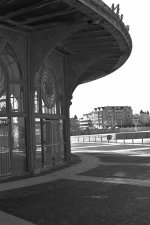Hello all! I'm pretty new to this whole gig and getting my feet under me with my new D5300. I was shooting yesterday and ran into a couple of situations where there was a huge dynamic range between the shadows and the bright sunlight. I set up the shot below and was pretty happy with the composition. I am pleased with the exposure on the building (it's green brass for reference), but I feel like the background is overexposed. Aside from HDR and bracketing the shot, is there any way to compensate for the huge difference in light?



